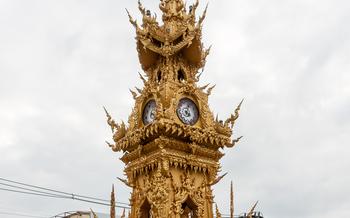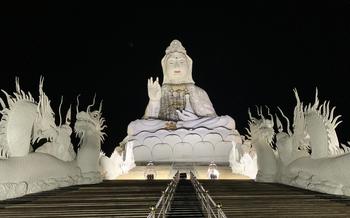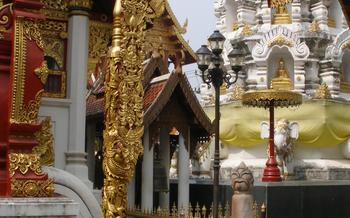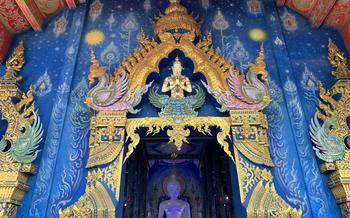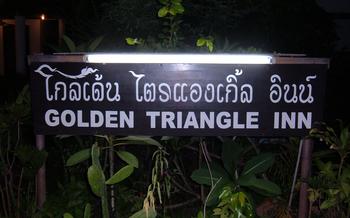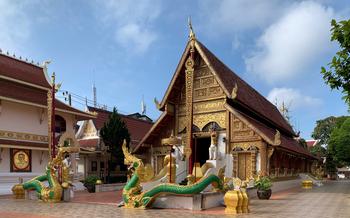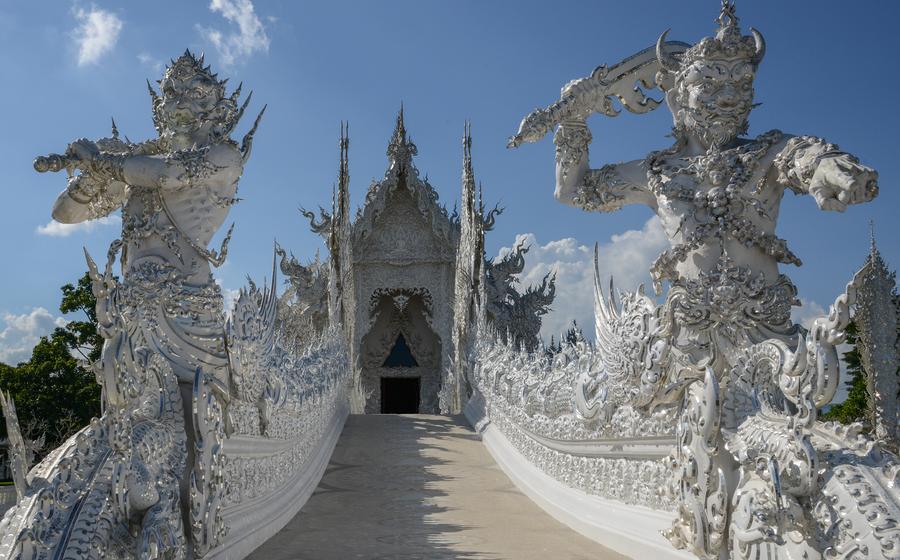
Chiang Rai Art Bridge
- Chiang Rai Art Bridge: A Cultural Masterpiece
- Exploring the Bridge: A Visual Journey
- The Art Installations: A Showcase of Talent
- The Night Transformation: Illuminating Art
- History and Heritage: A Bridge to the Past
- A Walk Through Time: Exploring the Surroundings
- Local Markets: A Feast for the Senses
- Transportation and Accessibility: Getting There
- Accommodation Options: A Place to Rest
- Dining Delights: Culinary Adventures
- Festivals and Events: A Celebration of Culture
- Sustainable Tourism: Preserving the Bridge's Legacy
- Beyond the Bridge: Exploring Chiang Rai Province
- Insider Tip: Unveiling a Hidden Gem
Chiang Rai Art Bridge: A Cultural Masterpiece
The Chiang Rai Art Bridge, a shining symbol of creativity and cultural unity, spans the Kok River, connecting the city's vibrant past with its promising future. Its construction in 2018 marked a defining moment for Chiang Rai, transforming it into a hub of contemporary art and cultural expression. The bridge serves as a canvas for local and international artists to showcase their talents, creating a unique and immersive experience for visitors from around the world.
The bridge's design, a testament to architectural ingenuity, seamlessly blends traditional Lanna elements with modern aesthetics. Its intricate metalwork and vibrant colors pay homage to the region's rich artistic heritage while embracing contemporary design principles. The bridge's pillars, adorned with stunning murals and sculptures, represent the diversity of Chiang Rai's art scene, showcasing a range of styles and techniques.
Beyond its physical structure, the Chiang Rai Art Bridge carries deep cultural significance. It symbolizes the unity and collaboration of local artists, working together to create a masterpiece that reflects the spirit of Chiang Rai. The bridge has become a platform for cultural exchange, fostering dialogue and understanding among artists from different backgrounds. It stands as a testament to the power of art to bridge gaps and bring people together.
Local artists have poured their hearts and souls into creating the bridge's unique installations. Each piece tells a story, capturing the essence of Chiang Rai's culture and traditions. From intricate carvings depicting mythical creatures to vibrant abstract sculptures, the bridge is a testament to the boundless creativity of the region's artists. Their contributions have transformed the bridge into a living, breathing work of art, constantly evolving and captivating visitors with its ever-changing landscape.
Exploring the Bridge: A Visual Journey
As you approach the Chiang Rai Art Bridge, a symphony of colors and forms greets you. The bridge is a visual masterpiece, a testament to the creativity and talent of local and international artists. Each step you take across the bridge reveals a new perspective, a new artwork waiting to be discovered.
Themed sections of the bridge showcase the diverse artistic styles and inspirations that came together to create this unique space. From abstract sculptures to intricate murals, every piece tells a story, inviting you to interpret and appreciate the artist's vision.
During my walk across the bridge, I was particularly struck by a series of ceramic tiles depicting scenes from Thai mythology. The vibrant colors and intricate details brought the legends to life, creating a magical and immersive experience.
The bridge is not just a static display of art; it's a living, breathing space where artists continue to create and exhibit their work. Pop-up exhibitions and live performances often take place, adding an element of surprise and dynamism to the bridge's already vibrant atmosphere.
The Art Installations: A Showcase of Talent
The Chiang Rai Art Bridge is not merely a pedestrian walkway; it is a living canvas that displays a diverse range of art forms, each piece contributing to the bridge's unique identity. Here, local and international artists have come together to showcase their talent and creativity, resulting in a breathtaking array of sculptures, paintings, and installations.
The bridge's art installations are not just decorative; they tell stories, convey messages, and reflect the spirit of Chiang Rai's art scene. One of the most iconic installations is the "Infinity Mirror Room" by Chalermchai Kositpipat. This room, filled with mirrors and LED lights, creates an illusion of infinite space and invites viewers to contemplate the nature of reality.
Another notable installation is the "Kinetic Wind Sculpture" by Kittiwat Un-Anong. This sculpture, made of hundreds of colorful metal pieces, dances and twirls in the wind, symbolizing the fluidity and impermanence of life. The "Tunnel of Light" by Araya Rasdjarmrearnsook is another mesmerizing sight, with its colorful lights and patterns that create a kaleidoscope-like effect.
Each installation on the Chiang Rai Art Bridge has its own story to tell, and visitors can spend hours exploring and discovering the hidden meanings and symbolism behind each piece. The bridge is a testament to the creativity and talent of the artists who have contributed to its creation, and it stands as a symbol of Chiang Rai's vibrant and diverse art scene.
The Night Transformation: Illuminating Art
As the sun sets over Chiang Rai, the Chiang Rai Art Bridge undergoes a magical transformation. The darkness is illuminated by a symphony of lights, casting an ethereal glow on the art installations and sculptures. The bridge comes alive with a new energy, as the interplay of light and shadow creates a breathtaking spectacle.
Walking across the bridge at night is an experience like no other. The once vibrant colors of the art installations are replaced by a soft, muted palette, giving the bridge a mysterious and enchanting aura. The reflections of the lights dance on the water below, creating a mesmerizing display that captivates the senses.
The lighting design on the bridge is a masterpiece in itself. Each installation is carefully illuminated to highlight its unique features and artistic intent. The result is a visual feast that showcases the talent and creativity of the artists involved.
I had the opportunity to experience the bridge at night on a clear and starry evening. The combination of the illuminated art installations and the twinkling stars above was simply breathtaking. It felt like walking through a dream, surrounded by a kaleidoscope of colors and lights.
If you are planning a visit to the Chiang Rai Art Bridge, make sure to include a night visit in your itinerary. It offers a completely different perspective and allows you to appreciate the bridge's beauty in a whole new light. The night transformation is truly a sight to behold, leaving an unforgettable impression on every visitor.
History and Heritage: A Bridge to the Past
The Chiang Rai Art Bridge stands as a testament to the rich cultural heritage of Chiang Rai. The area where the bridge is located holds significant historical importance, with tales of ancient kingdoms, legendary warriors, and spiritual traditions deeply entwined with the land.
The bridge's design incorporates elements that pay homage to Chiang Rai's past. The use of traditional Lanna-style architecture, with its intricate carvings and colorful motifs, creates a sense of continuity between the present and the past. The bridge's location, overlooking the Kok River, is also significant, as the river has long been a vital waterway for trade and transportation, connecting Chiang Rai to other parts of the region.
Stories of local legends and folklore add to the mystique of the area. One popular tale speaks of a mythical serpent that once guarded the river, a symbol of protection and prosperity. The serpent is said to have been appeased by offerings of flowers and incense, a tradition that is still practiced by some locals today.
The Chiang Rai Art Bridge serves as a bridge not only between art forms but also between the past and the present. It invites visitors to explore the cultural heritage of Chiang Rai, to delve into the stories and traditions that have shaped this vibrant and fascinating region.
A Walk Through Time: Exploring the Surroundings
The Chiang Rai Art Bridge is not just a standalone attraction; it is nestled in a neighborhood steeped in history and cultural significance. Take advantage of your visit to explore the surrounding area, where you'll find a treasure trove of historical landmarks, temples, and museums.
Start your walk at the nearby Wat Phra Kaew, a sacred Buddhist temple that houses the revered Emerald Buddha statue. Continue to the Chiang Rai National Museum, which showcases fascinating exhibits on the province's history and culture. Don't miss the opportunity to visit the Hilltribe Museum, where you can learn about the diverse ethnic groups that call Chiang Rai home.
For a glimpse into the city's artistic heritage, head to the Chiang Rai City Arts and Cultural Centre. Here, you can admire contemporary art exhibitions and take part in workshops. The nearby Night Bazaar is a vibrant hub of activity, where you can browse local handicrafts and indulge in delicious street food.
To experience the local way of life, wander through the bustling fresh market, where vendors sell an array of colorful fruits, vegetables, and spices. As you stroll along the streets, keep an eye out for charming cafes and restaurants, where you can savor authentic Thai cuisine or relax with a refreshing drink.
By combining a visit to the Chiang Rai Art Bridge with an exploration of the surrounding area, you'll gain a deeper appreciation for Chiang Rai's rich history, culture, and vibrant local life.
Local Markets: A Feast for the Senses
A visit to the Chiang Rai Art Bridge is incomplete without experiencing the vibrant local markets nearby. These bustling marketplaces offer a feast for the senses, immersing visitors in the sights, sounds, and aromas of everyday Thai life.
The markets are a treasure trove of local delicacies, fresh produce, souvenirs, and handicrafts. Street food stalls line the narrow alleys, enticing passersby with the mouthwatering aromas of pad thai, grilled meats, and tropical fruits. Vendors proudly display their wares, from colorful textiles and intricate silver jewelry to hand-carved wooden sculptures and traditional pottery.
Beyond the culinary and shopping delights, the markets also provide a glimpse into the local culture and traditions. They are a place where locals come together to socialize, exchange stories, and celebrate life. Visitors can witness the lively interactions between vendors and customers, learn about local customs, and gain a deeper appreciation for the warm hospitality of the Thai people.
Exploring the local markets is a sensory adventure that allows visitors to immerse themselves in the vibrant tapestry of Thai culture. It's an opportunity to taste the flavors, hear the sounds, and soak up the atmosphere of this dynamic and welcoming region.
Transportation and Accessibility: Getting There
Navigating the Routes to the Chiang Rai Art Bridge
Reaching the Chiang Rai Art Bridge is a breeze, with multiple transportation options available to suit every traveler's needs. For those seeking a budget-friendly option, the local public transportation system offers a convenient and affordable way to get there. Buses and songthaews (shared taxis) run regularly from various points in the city, making it easy to hop on and off at your leisure. Simply inquire with locals or at your hotel for the specific routes and schedules.
If you prefer a more personalized experience, taxis and tuk-tuks are readily available for hire. These can be negotiated for a fixed price or metered, depending on your preference. For those seeking the freedom to explore at their own pace, rental vehicles, including cars and motorbikes, can be rented from numerous agencies in Chiang Rai. This option provides the flexibility to not only visit the bridge but also venture further into the surrounding areas.
Finding the Bridge with Ease
Once you arrive in the vicinity of the Chiang Rai Art Bridge, finding it is a piece of cake. The bridge is strategically located within walking distance from the city center and other popular attractions. Simply follow the signs or ask for directions from locals, who are always happy to guide visitors. The bridge's unique design and vibrant colors make it easily recognizable, ensuring that you won't miss this architectural masterpiece.
Accommodation Options: A Place to Rest
When planning your visit to the Chiang Rai Art Bridge, finding suitable accommodation is essential. The area offers a range of options to cater to different preferences and budgets. From cozy guesthouses to luxurious hotels, there's something for every traveler.
For those seeking a budget-friendly option, guesthouses and hostels are readily available. These establishments often provide basic yet comfortable rooms at affordable prices. They also offer a chance to interact with fellow travelers and share experiences.
If you prefer a more upscale experience, several hotels near the bridge offer modern amenities and stunning views. These hotels often feature rooftop pools, fitness centers, and on-site restaurants, providing a relaxing and luxurious stay.
For a truly unique experience, consider booking a homestay with a local family. This is an excellent way to immerse yourself in the local culture and gain insights into daily life in Chiang Rai. Homestays typically offer comfortable rooms and delicious home-cooked meals.
When selecting your accommodation, consider your budget, desired amenities, and proximity to the bridge. Many accommodations within walking distance of the bridge allow you to easily explore the area on foot.
Remember to book your accommodation in advance, especially during peak tourist seasons, to secure the best deals and availability. Online booking platforms and local travel agents can assist you in finding the perfect place to stay during your visit to the Chiang Rai Art Bridge.
Dining Delights: Culinary Adventures
The area surrounding the Chiang Rai Art Bridge is a culinary paradise, offering a diverse range of dining options to satisfy every palate. From traditional Thai cuisine to international dishes, there's something for everyone to enjoy.
For those seeking an authentic Thai experience, local restaurants line the streets, serving up delicious dishes such as khao soi, a northern Thai curry noodle soup, and sai ua, a spicy grilled sausage. These restaurants offer a warm and inviting atmosphere, allowing visitors to immerse themselves in the local culture while savoring the flavors of Thai cuisine.
Street food stalls are also a popular choice, offering a variety of affordable and delicious snacks. From pad thai to som tum, there's no shortage of options to satisfy your cravings. These stalls provide a unique opportunity to interact with local vendors and experience the vibrant street culture of Chiang Rai.
For those seeking a more elevated dining experience, there are several restaurants in the area that offer international cuisine, including Italian, French, and Japanese. These restaurants often feature stunning views of the bridge and the surrounding landscape, creating a memorable dining experience.
Whether you're in the mood for a casual snack or a fine dining experience, the area around the Chiang Rai Art Bridge has something to offer every food enthusiast. Be sure to come hungry and ready to explore the culinary delights of this vibrant city.
Festivals and Events: A Celebration of Culture
Chiang Rai is a vibrant city that hosts a diverse range of festivals and events throughout the year, adding to its cultural allure. These celebrations showcase the city's rich heritage, traditions, and artistic expressions.
One of the most prominent events is the Chiang Rai Flower Festival, held annually in February. This festival transforms the city into a kaleidoscope of colors as locals and visitors alike celebrate the beauty of flowers. Elaborate floral arrangements, parades, and exhibitions fill the streets, creating a festive atmosphere.
Another highlight is the Lanna Cultural Festival, held in April. This festival pays homage to the region's Lanna heritage, featuring traditional performances, processions, and demonstrations of Lanna crafts and cuisine. Visitors can immerse themselves in the unique customs and traditions of this ancient kingdom.
For those interested in contemporary art, the Chiang Rai Art Festival in December is a must-visit. This festival brings together local and international artists to showcase their works in various mediums, including painting, sculpture, and photography. Exhibitions, workshops, and live performances create a vibrant platform for artistic expression and exchange.
To plan your trip around these festivals, it's advisable to check the official Chiang Rai Tourism website or consult with local tourism offices for the exact dates and schedules. Attending these events offers a unique opportunity to experience the cultural heartbeat of Chiang Rai and create lasting memories.
Sustainable Tourism: Preserving the Bridge's Legacy
As responsible travelers, it is essential to minimize our environmental impact and support local communities when visiting the Chiang Rai Art Bridge. Here are some tips for sustainable tourism:
-
Reduce Plastic Waste: Avoid single-use plastics by bringing your own water bottle and reusable bags. Properly dispose of any waste in designated bins.
-
Respect Local Customs: Be mindful of local customs and traditions. Dress appropriately and ask permission before taking photos of people or religious sites.
-
Support Local Businesses: Shop at local markets and buy souvenirs from local artisans. This helps to support the local economy and preserve traditional crafts.
-
Choose Eco-Friendly Accommodation: Opt for accommodations that prioritize sustainability, such as those using renewable energy or supporting community-based tourism.
-
Volunteer or Donate: Consider volunteering your time or making a donation to organizations working to preserve Chiang Rai's cultural heritage.
Initiatives are underway to promote sustainability at the bridge. These include recycling programs, educational workshops, and community-based projects. By embracing sustainable practices, we can help ensure that the Chiang Rai Art Bridge remains a vibrant cultural landmark for generations to come.
Personally, I believe that sustainable tourism is essential for preserving the unique charm and authenticity of destinations like the Chiang Rai Art Bridge. By traveling responsibly, we can contribute to the well-being of local communities and protect the environment, ensuring that future generations can continue to enjoy this extraordinary cultural masterpiece.
Beyond the Bridge: Exploring Chiang Rai Province
While the Chiang Rai Art Bridge is a must-visit destination, there's so much more to explore in the province beyond this iconic landmark. Chiang Rai is a treasure trove of natural wonders, historical sites, and cultural experiences waiting to be discovered.
For nature enthusiasts, the province boasts stunning landscapes, lush forests, and breathtaking waterfalls. Doi Mae Salong, a mountain range known for its tea plantations and panoramic views, is a popular destination for trekking and hiking. For a unique experience, visit the Mae Fah Luang Garden, a botanical garden showcasing a diverse collection of plants and flowers from around the world.
History buffs will delight in exploring Chiang Rai's ancient temples and historical sites. Wat Rong Khun, also known as the White Temple, is a modern architectural marvel with its intricate carvings and gleaming white facade. Wat Phra That Doi Chom Thong is another significant temple perched atop a hill, offering stunning views of the surrounding countryside.
For those seeking cultural immersion, Chiang Rai is home to several hill tribe villages, each with its own unique traditions and way of life. Visitors can interact with the villagers, learn about their customs, and purchase handmade crafts and souvenirs.
To fully experience Chiang Rai's charm, consider creating a well-rounded itinerary that combines visits to the Chiang Rai Art Bridge with other attractions and activities in the province. Whether you're interested in nature, history, or culture, there's something for everyone in Chiang Rai.
Insider Tip: Unveiling a Hidden Gem
Beyond the bustling streets and tourist hotspots, Chiang Rai Province conceals a trove of hidden gems waiting to be discovered. One such gem is the secluded Wat Huay Pla Kang, a serene temple nestled amidst tranquil rice fields just a short distance from the Chiang Rai Art Bridge.
To find this hidden sanctuary, follow a narrow path that winds through lush greenery, leading you to a tranquil oasis of peace and tranquility. As you approach the temple, the sound of gently flowing water from a nearby stream fills the air, creating a soothing ambiance that invites you to leave your worries behind.
The temple's main attraction is its unique architecture, which blends traditional Lanna-style elements with modern design. The main prayer hall features intricate carvings and murals depicting scenes from Buddhist mythology, while the surrounding grounds are adorned with beautiful gardens and serene ponds.
The highlight of Wat Huay Pla Kang, however, is its resident monk, who is renowned for his wisdom and kindness. Visitors are welcome to engage in conversations with him, seeking guidance and blessings. His teachings are deeply rooted in Buddhist principles, emphasizing compassion, mindfulness, and the pursuit of inner peace.
Discovering Wat Huay Pla Kang was a truly enriching experience. It offered a glimpse into the spiritual side of Chiang Rai, allowing me to connect with the local culture on a deeper level. The temple's serene atmosphere and the wisdom shared by its resident monk left a lasting impression, reminding me of the importance of finding moments of peace and reflection amidst the hustle and bustle of everyday life.
I encourage fellow travelers to venture beyond the main tourist attractions and seek out hidden gems like Wat Huay Pla Kang. These lesser-known places often hold the most authentic and rewarding experiences, providing a unique perspective on the rich cultural heritage of Chiang Rai. Embrace the spirit of exploration, and you may just stumble upon your own hidden treasure.


